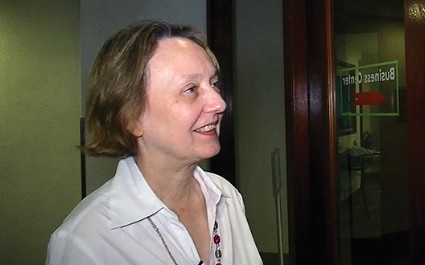User login
PALM BEACH, ARUBA – Chemotherapy can trigger a host of skin presentations, the specific histologies of which may not be as recognizable to oncologists and hematologists as they would be to dermatologists and primary care physicians. Dr. Jean L. Bolognia, professor of dermatology and vice chair of clinical affairs at Yale University, New Haven, Conn., suggests that by using the all-encompassing clinical term "toxic erythema of chemotherapy," a common ground can be established between all members of a patient’s cancer treatment team, and better outcomes achieved.
In this podcast, Dr. Bolognia offers clinicians specifics for determining when a patient is experiencing a cutaneous reaction to chemotherapy or biologics vs. other skin diseases, and suggests ways to adjust treatment to lessen skin reactions. "It requires adjusting some of the misconceptions about drug eruptions," advises Dr. Bolognia. "This is a toxic reaction, not an allergic one." The distinction is important, according to Dr. Bolognia, especially if the patient is responding to their primary treatment; rather than stop a medication, the timing and dosage can be changed.
Among other tips, such as which drugs create certain drug eruptions, Dr. Bolognia reminds dermatologists and primary care clinicians including physician’s assistants that even a month after treatment, cutaneous reactions are possible.
On Twitter @whitneymcknight
PALM BEACH, ARUBA – Chemotherapy can trigger a host of skin presentations, the specific histologies of which may not be as recognizable to oncologists and hematologists as they would be to dermatologists and primary care physicians. Dr. Jean L. Bolognia, professor of dermatology and vice chair of clinical affairs at Yale University, New Haven, Conn., suggests that by using the all-encompassing clinical term "toxic erythema of chemotherapy," a common ground can be established between all members of a patient’s cancer treatment team, and better outcomes achieved.
In this podcast, Dr. Bolognia offers clinicians specifics for determining when a patient is experiencing a cutaneous reaction to chemotherapy or biologics vs. other skin diseases, and suggests ways to adjust treatment to lessen skin reactions. "It requires adjusting some of the misconceptions about drug eruptions," advises Dr. Bolognia. "This is a toxic reaction, not an allergic one." The distinction is important, according to Dr. Bolognia, especially if the patient is responding to their primary treatment; rather than stop a medication, the timing and dosage can be changed.
Among other tips, such as which drugs create certain drug eruptions, Dr. Bolognia reminds dermatologists and primary care clinicians including physician’s assistants that even a month after treatment, cutaneous reactions are possible.
On Twitter @whitneymcknight
PALM BEACH, ARUBA – Chemotherapy can trigger a host of skin presentations, the specific histologies of which may not be as recognizable to oncologists and hematologists as they would be to dermatologists and primary care physicians. Dr. Jean L. Bolognia, professor of dermatology and vice chair of clinical affairs at Yale University, New Haven, Conn., suggests that by using the all-encompassing clinical term "toxic erythema of chemotherapy," a common ground can be established between all members of a patient’s cancer treatment team, and better outcomes achieved.
In this podcast, Dr. Bolognia offers clinicians specifics for determining when a patient is experiencing a cutaneous reaction to chemotherapy or biologics vs. other skin diseases, and suggests ways to adjust treatment to lessen skin reactions. "It requires adjusting some of the misconceptions about drug eruptions," advises Dr. Bolognia. "This is a toxic reaction, not an allergic one." The distinction is important, according to Dr. Bolognia, especially if the patient is responding to their primary treatment; rather than stop a medication, the timing and dosage can be changed.
Among other tips, such as which drugs create certain drug eruptions, Dr. Bolognia reminds dermatologists and primary care clinicians including physician’s assistants that even a month after treatment, cutaneous reactions are possible.
On Twitter @whitneymcknight
EXPERT ANALYSIS FROM CARIBBEAN DERMATOLOGY SYMPOSIUM 2014
